
The Arts
European art can be found in the Library of Congress in all possible forms, representing every corner of the continent, and giving a broad picture of the artistic achievements of the peoples of Europe. One can get a birds-eye view of this diversity by browsing through major European art encyclopedias and countless art books or by listening to and viewing the works of major European artists in music, film, photography, and folk art. Moreover, the European heritage of the founders of the Library is evident in the style of the very building in which mnay of these treasures have been preserved. With its facade modeled after the Paris Opera House and its Great Hall after the Grand Foyer of the Vienna Opera House, the Library's Jefferson Building could be likened to a jewelry box that is "lined" in the Great Hall, corridors, Main Reading Room, and smaller reading rooms with the decorative work and design of Italian and American artists in the manner of many European palaces.
 Franjo Filipovic. Winter. One of the best examples of South Slav naive art, which is well represented in the collections of the Library of Congress.(From Oto Bihalji-Merin, Primitive Artists of Yugoslavia, [Belgrade, 1964, p. 49) (General Collections)
Franjo Filipovic. Winter. One of the best examples of South Slav naive art, which is well represented in the collections of the Library of Congress.(From Oto Bihalji-Merin, Primitive Artists of Yugoslavia, [Belgrade, 1964, p. 49) (General Collections)
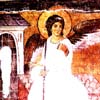 Angel on Christ's Tomb, a detail from a fresco in the monastery Mileseva, 1234. The "White Angel", inspiration for later poetry, is a beautiful example of the golden age of old South Slavic church art. (From M. Klaríc, Yugoslavia: A Journey Through Her Art [Belgrade,1973], plate xx.) (General Collections)
Angel on Christ's Tomb, a detail from a fresco in the monastery Mileseva, 1234. The "White Angel", inspiration for later poetry, is a beautiful example of the golden age of old South Slavic church art. (From M. Klaríc, Yugoslavia: A Journey Through Her Art [Belgrade,1973], plate xx.) (General Collections)
In view of this architectural setting, it is not surprising that the Library has become a treasure house of valuable and rare art works, book collections, manuscripts, correspondence, and other original material of world-famous artists, musicians, composers, filmmakers, craftsmen, and dramatists.
The Music Division is the custodian of the Library's strongest assemblage of materials in the arts. More than half of the items in some 600 donor-named collections, each ranging in content from a dozen to half a million items, are of European origina. The Library holds 252 music manuscripts by Franz Lizst and many printed scores hand-annotated by Liszt himself. Original manuscripts by Béla Bartók and Zoltán Kodály join autographed scores and correspsondence by such composers as Johann Sebastian Bach, Alban Berg, Anton Bruckner, Richard Strauss, Richard Wagner, and Hugo Wolf. The Library's Johannes Brahms holdings are the largest outside Vienna.
Of particular importance is the Albert Schatz Collection of 12,000 German and Italian librettos from the seventeenth and eighteenth centuries, the most complete collection of librettos in the world. The Library owns the original manuscript of Debussy's Trois Nocturnes, the 1470 manuscript of Laborde's Chansonnier, a 1516 edition of Liber primus missaru by the Flemish composer Josquin des Pres, and the very rare Il Primo Libro delli madrigal d'Orlando di Lassus by the Dutch composer Orlandus Lassus (Rome: Dorico, 1560), of which only one other complete copy is known to exist. Students of music many view holograph scores by Guiseppe Verdi, Nicola Porpora, and Niccolò Paganini (in addition to documents, papers, and other materials in the Paganini collection).
Material on the music of Spain includes musical scores of medieval, Renaissance, and baroque dramas, Catalan songs, "zarzuelas," and works of Manuel de Falla, Isaac Albeniz, and Andrés Segovia.
The Music Division also holds autographed first editions of works by Frédéeric Chopin and autographed scores by other Polish composers such as Ignacy Paderewski and Krzysztof Penderecki, among others. The treasures of the Russian music holdings are the archival collections, particularly the Rachmaninoff Archives and the Serge Koussevitzky Music Collection, with numerous original scores, correspondence, notes, diaries, and photographs of major musical personalities throughout the world. The Library also has an impressive set of scores by Czech composers Bedrich Smetana, Anton´n Dvorák, and Leos Janácek, among others. Especially strong is the collection of Czech chamber music, represented by several baroque and early classical figures.
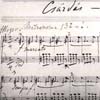 First page of Two Csárdás,
No. 1 Allegro (s225:1), dates 1884, by the Hungarian composer Franz Liszt. Written in Liszt's own hand, this item is part of the Rosenthal Collection, held by the Music Division of the Library of Congress. (Music Division)
First page of Two Csárdás,
No. 1 Allegro (s225:1), dates 1884, by the Hungarian composer Franz Liszt. Written in Liszt's own hand, this item is part of the Rosenthal Collection, held by the Music Division of the Library of Congress. (Music Division)
In the Music Division a researcher can find the original recordings of concerts given in the Library of Congress by Gergor Piatigorsky, Artur Rubinstein, the Budapest String Quartet, George Szell, Leopold Stokowski, Claudio Arrau, and others. Musicians can see instruments made by outstanding European artisans, such as the five-strong instruments crafted by Antonio Stradivari between 1697 and 1727, the "Brookings" violin made in 1654 by Niccolò Amati, and six-string instruments that are the work of renowned Dutch, French, German, and Italian artisans of the seventeenth and eighteenth centuries, donated to the Library by Dr. H. Blaikiston Wilkins. This priceless musical heritage continues to be a focus of interest of many American and European specialists and a valuable source for radio and television programs.
Original scores of contemporary European composers such as Béla Bartók, Henri Dutilleux, Arthur Honneger, Darius Milhaud, Francis Poulenc, Igor Stravinsky, and Iannis Xenakis have been added to the collections through the Library's Serge Koussevitzky Endowment to commission new musical compositions and continue the annual programs where these commissions are performed.
The Gertrude Clarke Whittall Foundation and the Elizabeth Sprague Coolidge Foundation were established in 1934 and 1935, respectively, to support chamber music composition and performance. The Coolidge Collection includes holographs of the more than 300 compositions by eminent twentieth-century composers commissioned by the foundation, as well as Mrs. Coolidge's own compositions and works dedicated to her. The Whittall Collection was begun with the presentation of five Stradivari instruments to the Library of Congress on the condition that they be played at the Library by a quartet in residence. The collection was augmented over the years by original eighteenth-, nineteenth-, and twentieth-century manuscripts, the correspondence of famous European composers, and two special units within the collection: the Niccolo Paganini archive of correspondence, notebooks, musical manuscripts, and posters, many acquired from the Paganini family; and the autographed letters and printed music of Felix Mendelssohn.
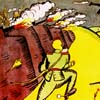 Kazimir Malevich. Kaiser Wilhelm's
Merry-Go-Round (Moscow, 1915?). Executed in traditional Russian
"lubok" or folk style, the poster caricatures the German emperor's early
defeats in World War I, quoting him complai ning that "I run around and
accomplish nothing." (Russian Poster Collection, Prints
and Photographs Division)
Kazimir Malevich. Kaiser Wilhelm's
Merry-Go-Round (Moscow, 1915?). Executed in traditional Russian
"lubok" or folk style, the poster caricatures the German emperor's early
defeats in World War I, quoting him complai ning that "I run around and
accomplish nothing." (Russian Poster Collection, Prints
and Photographs Division)
After music, the next largest volume of material in the arts is the collection of books on the performing arts--on theater, dance, film, and folk arts--where, again, the European influence is pronounced. Here one discovers remarkable holdings. The George Fabyan collection on the controversy over the authorship of Shakespeare's plays includes thirty-three original works by Sir Francis Bacon published between 1597 and 1640, and the Francis Longe collection of theatrical adaptions, and translations of over six hundred playwrights.
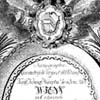 Joseph Daniel von Huber. Scenographie
(Vienna,1777). The title sheet of a twenty four-sheet detailed map
of Vienna that was pieced together to make a composite map measuring 350
cm by 410 cm. (Geography and
Map Division)
Joseph Daniel von Huber. Scenographie
(Vienna,1777). The title sheet of a twenty four-sheet detailed map
of Vienna that was pieced together to make a composite map measuring 350
cm by 410 cm. (Geography and
Map Division)
The Lessing J. Rosenwald Collection of 2,600 rare books from the fifteenth through the twentieth centuries, described more fully in the Rare Books and Manuscripts section below, contains books illustrated by Bonnard, Braque, Chagall, Derain, Dufy, Picasso, Rouault, Toulouse-Lautrec, and Utrillo.
For the study of achievements in the plastic arts, the Library has a rich collection of art catalogs from the most important national, international, and individual exhibitions of prominent artists from almost every European country, as well as prints and posters with unique artistic, historic, and scientific value. Of particular interest are the drawings in the Alfred Marie Collection of French renaissance and baroque architecture relating especially to Versailles and other French imperial building projects. The French Political Cartoon Collection encompasses over 200 prints produced between 1789 and 1830 devoted to the French Revolution and the reign of Napoleon Bonaparte. Students of European architecture can find remarkable illustrated volumes, such as the Life of Thomas Telford, Civil Engineer and Peter Henry Emerson's Life and Landscape on the Norfolk Broads (published in only 200 copies, with forty platinotypes), as well as rich collections of prints of Austrian baroque buildings and Balkan architecture showing strong Eastern and Byzantine influences. In the folio collections, Villas, Maisons de Ville et de Campagne by L. Isabey and E. Leblan contains fifty-five chromolithographed plates of the best examples of the heavily ornate style of mid-nineteenth-century France.
Important documents on the history of cinematography and its European heritage are to be found in the collection of the pioneering French filmmaker Georges Mélìs. Among the 12,550 films from twenty-three countries held by the Library of Congress, there are approximately fifty early works from France by Goumont, Pathe, and Cines. The Library's German film collection contains 4,000 feature films, newsreels, and shorts from the Weimar and Third Reich periods alone, among other works. The Italian collection has five hundred documentaries, newsreels, and feature films produced between 1930 and 1943, as well as more contemporary examples of Italian cinematography. Recently the Library has acquired a comprehensive collection of prerevolutionary Russian silent films to add to the existing collection of early Soviet films. Eastern Europe is also represented by filmmakers such as Emir Kosturica, Dusan Makavejev, and Alexander Korda.
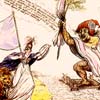 W. Brown. The Great Monster, Republican...
(April 1798). Initial British support of the French Revolution waned
with the onset of the Terror . By 1798 republicanism was depicted as a
monster. (Popular and Applied Graphic Arts Collection, Prints
and Photographs Division)
W. Brown. The Great Monster, Republican...
(April 1798). Initial British support of the French Revolution waned
with the onset of the Terror . By 1798 republicanism was depicted as a
monster. (Popular and Applied Graphic Arts Collection, Prints
and Photographs Division)